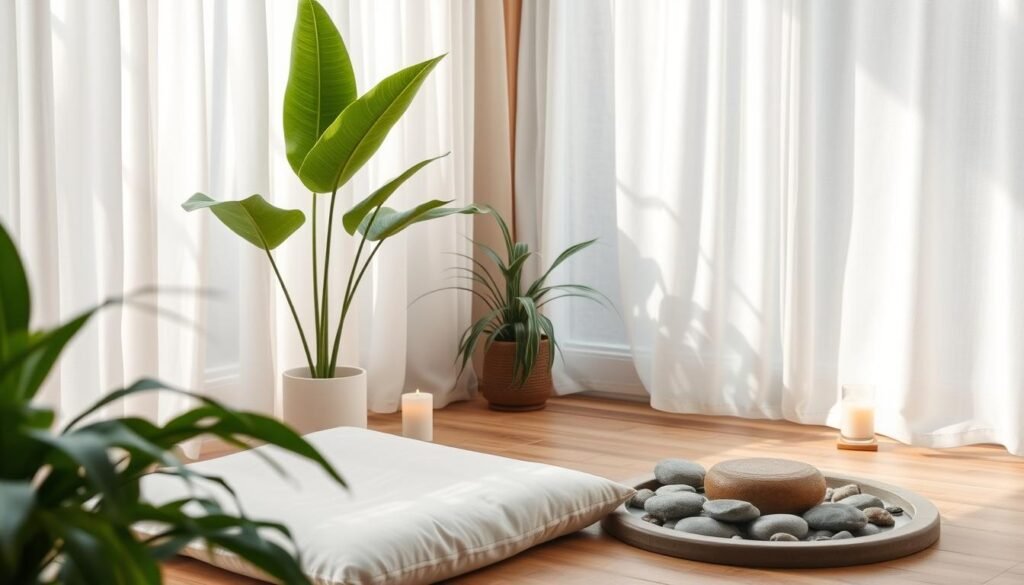Did you know that around 2-3% of adults in the U.S. have panic disorder at some point? Panic attacks are sudden waves of intense fear or discomfort. They are scary but usually not harmful. Effective breathing techniques for panic attacks people with anxiety can be very helpful. These simple calming breathing methods can greatly lower stress levels. They help regain control during intense moments.
This article looks at various anxiety relief breathing exercises. They aim to improve emotional well-being. Techniques like the 4-7-8 method, Lion’s breath, and alternate nostril breathing can decrease heart rate and breathing. They offer essential relief during panic attacks. Each exercise is a tool ready to use whenever anxiety hits. They guide individuals to a calmer state of mind.
For more detailed info on breathing exercises, visit this useful resource.
Key Takeaways
- Panic attacks affect about 2-3% of adults in the U.S.
- Breathing exercises can effectively manage symptoms during a panic attack.
- The 4-7-8 technique is a well-known method for reducing anxiety.
- Practices like Lion’s breath promote a yogic approach to calming.
- Deep and mindful breathing can lower heart rates and ease tension.
- Tracking panic attack symptoms may aid in identifying triggers.
Understanding Panic Attacks and Their Symptoms
Panic attacks come as sudden bursts of fear or discomfort. They can occur without warning. Often, they happen when someone is driving, at an event, or sleeping. Not everyone experiences panic attacks frequently. Some might have them just once or twice, often during stressful times.
The symptoms of panic attacks hit hard and fast. They usually reach their worst quickly. Symptoms include:
- Chest pain
- Sweating
- Difficulty breathing
- Rapid heartbeats
- Fatigue after the attack subsides
Studies show that women are more prone to panic attacks than men. They often start in the late teens or early adulthood. Several factors may increase their likelihood. These include family history, major stress, traumatic events, and big life changes. Additionally, smoking and past childhood abuse can contribute.
Without treatment, panic attacks can lead to bigger issues. Possible complications are phobias, the need for more medical help, avoiding social settings, job challenges, and higher chances for serious psychiatric conditions, substance abuse, and agoraphobia. It’s important to take anxiety symptoms seriously and get help.
Preventing panic attacks effectively means getting help early. Following a treatment plan and staying active can greatly reduce anxiety.
| Factor | Description |
|---|---|
| Occurrence | Can happen several times a day or a few times a year. |
| Gender Prevalence | Affects more women than men. |
| Treatment Options | Includes antidepressants, beta-blockers, and benzodiazepines. |
| Age of Onset | Typically begins in late teens or early adulthood. |
| Impact of Untreated Attacks | Can lead to social avoidance, work problems, and increased psychiatric risks. |
Importance of Breathing Techniques in Managing Anxiety
Breathing techniques are key in fighting anxiety. They can cause important changes in the body that reduce anxiety symptoms. With regular use, these methods can slow the heart rate and soothe the nervous system. This brings peace of mind.
Studies show breathing strategies can be very effective. Out of 72 techniques tested, 54 worked well in easing stress and anxiety. The best methods avoid quick breathing and last more than five minutes. They rely on guidance from professionals, repeated sessions, and continuous practice.
Breathing exercises also help fix common breathing issues linked to anxiety, like hyperventilation. They not only lower anxiety but also improve mood and help with trauma. This significantly betters a person’s skill in controlling panic attacks. Adding breathing methods to daily life lets people better handle their feelings and physical reactions. This is crucial in dealing with anxiety’s challenges.
Breathing Techniques for Panic Attacks People with Anxiety
Breathing techniques are key for handling panic attacks and anxiety. They help you take back control of your breathing during an attack. Learning calming breathing exercises can help you deal with panic more effectively.
Overview of Breathing Exercises
There are many breathing methods for panic attacks. Some popular ones include:
- Panic attack breathing exercises
- Controlled breathing for panic attacks
- Diaphragmatic breathing
- Box breathing
Practicing these regularly is crucial. It builds a habit that shifts focus to calmness during panic. This can make panic attacks less intense.
How Breathing Exercises Help Calm Panic Attacks
Breathing exercises trigger the body’s relaxation response. They help by:
- Encouraging deep breaths for optimal lung oxygen exchange.
- Slowing breathing to counteract hyperventilation.
- Moving focus from stressful thoughts to breathing.
These methods ease panic symptoms and aid in long-term anxiety control. Regular use improves overall well-being, leading to fewer panic episodes. Mixing breathing exercises with cognitive-behavioral therapy (CBT) can also help greatly.
| Technique | Benefits | Duration |
|---|---|---|
| Panic Attack Breathing | Regains control during an attack | 5-10 minutes |
| Diaphragmatic Breathing | Promotes relaxation and reduces anxiety | 5-15 minutes |
| Box Breathing | Enhances focus and reduces stress | 4-5 minutes |
Using these techniques helps manage anxiety well and improves your life quality.
4-7-8 Breathing Technique: A Step-by-Step Guide
The 4-7-8 breathing technique was created by Dr. Andrew Weil. It’s a great way to deal with anxiety and promote calmness. This method uses a specific breathing pattern to help lessen anxiety symptoms and improve one’s well-being. Originating from ancient traditions, it’s become well-liked for its stress-reducing and heart health benefits.
How to Perform the 4-7-8 Technique
To use the 4-7-8 breathing technique right, here are some simple steps:
- Begin by finding a comfortable position, either sitting or lying down.
- Close your eyes and take a deep breath in through your nose, counting to four.
- Hold your breath for a count of seven.
- Slowly exhale through your mouth for a count of eight, making a whoosh sound.
- Repeat this cycle for a total of four breaths, gradually increasing repetition as you become accustomed to the practice.
This method helps with anxiety by calming the parasympathetic nervous system. With regular use, it can better your heart rate, lower blood pressure, and improve your life quality. Though not widely studied, many say the 4-7-8 method significantly eases anxiety.
Adding this breathing exercise to your daily life helps you deal with stress better. Dr. Young suggests doing the 4-7-8 breathing technique two times a day for the best results. It’s okay to tweak it if you’re just starting and feel a bit dizzy from slow breathing.

| Step | Description |
|---|---|
| 1 | Inhale deeply for 4 seconds. |
| 2 | Hold your breath for 7 seconds. |
| 3 | Exhale slowly for 8 seconds. |
| 4 | Repeat the cycle four times. |
Lion’s Breath: A Yogic Approach to Calming Anxiety
Lion’s Breath is a standout yogic breathing technique for stress relief. It helps calm the mind and release body tension. By doing Lion’s Breath, one can effectively fight anxiety feelings.
Benefits of Lion’s Breath for Stress Relief
The practice of Lion’s Breath starts with a deep breath in through the nose. Then, you breathe out through your mouth with your tongue out. This action lets you let go of anxiety and stress.
- Alleviation of stress: Lion’s Breath directly addresses the perceived pressures that contribute to anxiety.
- Physical tension release: The strong exhalation assists in loosening tight muscles, thereby promoting relaxation.
- Increased confidence: Engaging in this technique can boost self-assurance as it incorporates assertive body language.
- Enhancement of mood: The act of vocalizing during exhalation can uplift spirits through a simple yet effective method of emotional expression.
Adding Lion’s Breath to your daily routine offers long-term stress relief. This ancient yogic practice is still key in today’s wellness. It shows the importance of breathing for mental health.
Alternate Nostril Breathing: Balancing Mind and Body
Alternate nostril breathing, also known as nadi shodhana, is a powerful method for balancing the mind and body. It involves breathing in through one nostril while the other is closed. Then, you switch nostrils to exhale. This technique can bring calmness and mental clarity.
Many studies have shown the benefits of this breathing technique. A 2020 study found that medical students had better pulse rates and blood pressure after four weeks of practice. Another study in 2018 showed men feeling less stressed after doing this breathing daily for three months. These findings prove it helps manage anxiety.
Alternate nostril breathing not only eases stress but also improves how we breathe. It has been linked to better lung function. Athletes and others looking to improve physical performance might find it useful. It also helps people who’ve survived abuse or live with chronic diseases feel less anxious and stressed.
To get the best results, do alternate nostril breathing twice daily. It can reduce your heart rate and blood pressure, helping you relax in stressful times. However, if you have asthma or heart issues, talk to a doctor before starting this practice. It’s an important precaution.
Adding this breathing method to your daily habits can create more balance and peace. It’s especially helpful for those dealing with anxiety and stress. Practicing regularly offers a path to serenity and better health.
Simple Deep Breathing Exercises for Anxiety Relief
Deep breathing techniques are key in beating anxiety and stress. By focusing on proper breathing, you can trigger your body’s chill-out response. This helps lessen anxiety feelings. Here, we’ll share some deep breathing exercises to help you feel more relaxed and calm.
Guided Deep Breathing Techniques to Try
Adding breathing exercises for anxiety relief to your day can boost your mental health. Here are a few good ones:
- Diaphragmatic Breathing: Focus on using your diaphragm. This lets you take deeper breaths, easing the work your body does to breathe.
- Resonant Breathing: Inhale slowly for six seconds, then exhale for six seconds. This pattern can relax you and help with anxiety.
- Equal Breathing: Inhale and exhale for the same amount of time. This is based on pranayama yoga and boosts relaxation and mental focus.
- Pursed-Lip Breathing: Inhale through your nose, then exhale through pursed lips. It’s good for controlling your breath, especially for those with lung problems.
- Belly Breathing: Spend 20-30 minutes on this each day to reduce anxiety, says The American Institute of Stress.
Additional Techniques
Guided meditation can stop negative thoughts that heighten stress. Combining this with breathing exercises works well for anxiety management. Regular practice of these techniques offers quick relief and improves your breathing health over time.
| Technique | Duration | Benefits |
|---|---|---|
| Diaphragmatic Breathing | 5-10 minutes | Reduces breathing effort, activates relaxation |
| Resonant Breathing | Up to 10 minutes | Promotes calmness and reduces anxiety |
| Equal Breathing | 5-10 minutes | Enhances mental clarity and relaxation |
| Pursed-Lip Breathing | As needed | Controls breath, aids those with lung issues |
| Belly Breathing | 20-30 minutes daily | Decreases stress, promotes relaxation |
Mindful Breathing Techniques You Can Practice Anywhere
Many people look for ways to ease anxiety in their daily lives. Mindful breathing techniques are a flexible way to calm the mind and body anywhere. These methods, like focusing on your body and counting breaths, make it easy to add mindfulness to your day. They’re key in helping lower anxiety.
One effective method is cyclic sighing, which uses a certain way to breathe in and out. It not only slows down your breathing but also helps your body feel calm. Those who try this controlled breathing feel more positive overall. Practicing cyclic sighing can really boost your mood and well-being.

You can practice mindfulness for anxiety almost anywhere – at home, work, or while traveling. These techniques are easy to fit into your schedule, helping you find peace wherever you are. By bringing mindful breathing into your daily life, you gain more awareness and a calmer mind.
Using these techniques regularly can improve how you handle emotions and enhance your well-being. Studies show that breathing methods can greatly reduce anxiety, leading to better health. As you get used to these practices, you’ll see benefits not just while doing the exercises but all day long. Starting mindful breathing is a powerful way to deal with anxiety better.
To learn more about how simple exercises can help with anxiety relief, check out this comprehensive guide. It has more information and tools to help you on your mindfulness journey.
Using Controlled Breathing for Panic Attacks
Panic attacks can feel overwhelming, making you think you’re losing control. Controlled breathing is a strong way to get relief during these times. In big US cities, 60 percent of ambulance calls are for ‘panic breathing.’ This shows how crucial it is to manage anxiety.
When anxiety spikes, your breathing can become fast, leading to hyperventilation. The brain then gets 40% less oxygen after just a minute of this. That’s why it’s important to control your breathing to fight panic symptoms. Techniques like pacing your breath and breathing from your diaphragm can help a lot.
Controlled breathing helps right away but it also makes you better at handling stress over time. For people who often get panic attacks, this is really helpful. A study showed that deep breathing exercises can make you more focused and stable emotionally. You can learn more about managing anxiety at here.
Learning to breathe in a controlled way is key for dealing with panic attacks. If you practice regularly, you can control your feelings better. This can lead to fewer panic attacks.
| Technique | Description | Benefits |
|---|---|---|
| Controlled Breathing | Focuses on steady and rhythmic inhalations and exhalations. | Reduces heart rate, lowers stress levels |
| Diaphragmatic Breathing | Breath originates from the diaphragm rather than shallow chest breathing. | Increases oxygen intake, calms the nervous system |
| 4-7-8 Breathing | Inhale for 4 seconds, hold for 7, exhale for 8. | Improves relaxation and reduces anxiety |
Incorporating Relaxation Techniques with Breathing Exercises
Adding relaxation methods to breathing exercises boosts their power. These approaches lower stress and help the body manage stress better. By mixing relaxation with breathing, you can feel calmer and more in control of your emotions.
Combining Relaxation with Breathing for Optimal Effect
Progressive muscle relaxation is one way to ease anxiety with breathing. You tense and relax your muscles one by one. This method makes you more aware of muscle tension. Pairing it with slow, deep breaths helps release stress and brings peace.
Using visualization is another effective tactic. Picture a peaceful place to engage your senses and mentally step away. When you add controlled breathing, it deepens the feeling of being in the moment and reduces anxiety. Autogenic relaxation involves calming thoughts or phrases. It boosts relaxation while deeply breathing.
It’s vital to practice these methods regularly. Doing them about twice a week works best. This schedule helps handle stress and sleep problems well. As you get better at noticing anxiety signs, you’ll learn to use these strategies daily. This builds up your guard against anxiety triggers. For more ways to manage anxiety through breathing, see breathing exercises for anxiety.

Creating a Regular Breathing Exercise Routine
Starting a breathing exercise routine is key to managing anxiety well. If you practice regularly, you’ll see big improvements in your well-being. This helps a lot with handling daily stress. Starting can seem hard, but small and easy goals make it simpler.
There are different ways to fit breathing exercises into your day. You can try the 4-7-8 breathing technique or box breathing. These can be done even on busy days for stress relief. Just 20 to 30 minutes of deep breathing can reduce anxiety and make you feel more stable emotionally.
Making the exercises slightly harder over time helps you grow without feeling too challenged. If you’re just starting, begin with simple diaphragmatic breathing. Then, you can move to more organized routines.
Sticking with it brings many benefits. You’ll handle stress better, feel less panic, and be calmer overall. These benefits come from better breath control and being more mindful of stress during the day.
Conclusion
Studies show breathing techniques really help people with anxiety. Over 1300 studies, including 12 major tests on adults, confirm this. They reveal breathing exercises reduce stress more than doing nothing. This shows how powerful these techniques can be in fighting anxiety.
Trying out different breathing methods, like the 4-7-8 technique, helps a lot with panic attacks. This article talks about how these methods work right away and help even more over time. By making these exercises a habit, and living a healthy life, you can really boost your mental health.
Panic attacks can happen without warning and feel really scary. Learning and using the right breathing exercises can give you back control. If you keep practicing different techniques, you’ll feel better overall. It’s a step towards a more peaceful and balanced life.